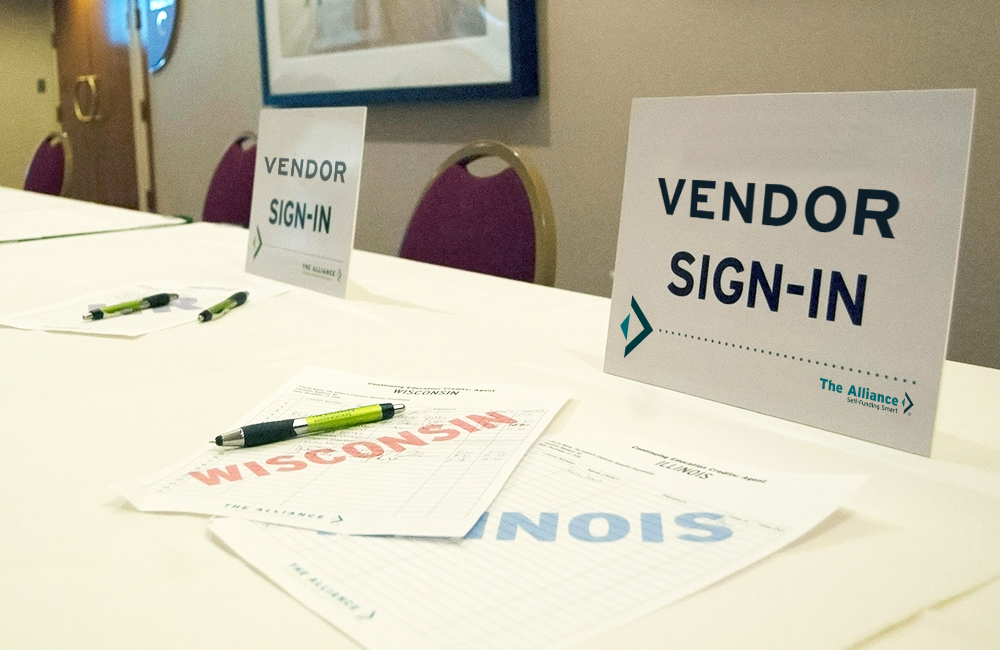
What Are The Benefits of Hosting a Vendor Summit?
As you begin the new year, you’re probably reassessing your benefit plan and vendor partners to help improve your employees’ health and wellbeing.
If you want to enhance your employee experience, reduce spending waste, and improve vendor efficiency, consider holding a vendor summit for all your health benefit programs.
What is a Vendor Summit?
Employers often organize health-related benefit programs separately, independent of one another. The result can be a patchwork of overlapping vendors, who often target the same group of employees and family members with chronic conditions.
Vendor summits bring together all partners for a meeting that can help employers get more from their health benefits investment; by having all your vendors together at the same table, you provide an opportunity for them to develop meaningful relationships with one another, which helps them work better together.
There are various focal points you can target when holding a vendor summit, but one The Alliance has seen work well is to pinpoint common, chronic conditions because those are typically the most costly and controllable items from a health spend standpoint.
Additionally, vendor summits highlight areas of accountability for your stakeholders and getting together as a team increases everyone’s effectiveness.
Which “Vendors” Should be Invited?
A vendor summit brings together all your outside vendors and partners to identify services and set goals as part of an integrated approach to health, disability, and absenteeism. Early in your plan year, you should send a meeting invite to all the vendors who help you manage health-related services. Those stakeholders could include:
- Broker/consultant
- Primary network (The Alliance)
- Pharmacy benefit manager (PBM)
- Third-Party Administrator (TPA)
- Employee assistance program (EAP)
- Wellness program
- Disease management/care management
- Disability
- Telehealth
- Workers’ compensation
- Other internal resources (on-site clinic, mental health, etc.)
If you are unsure on what services you should be including or who to invite, consult your broker – they should be able to help you gather your invite list and guide you through the process.
Preparing for the Vendor Summit
Before holding your summit, you should first analyze your benefit data to identify the top conditions driving your largest health care costs. This information will be invaluable in working with vendors and setting goals.
If you self-fund with The Alliance, contact your account executive to request a Smarter Health℠ analysis; its data includes claims history, provider utilization, cost trends, and more. Smarter Health reporting provides the foundation for a successful steerage program – one that guides employees to high-value health care – and the insights it provides would be invaluable for your vendor summit.
Additionally, you should ask each vendor to do some advance preparation. For example, in the invitation you could ask them to identify the top five conditions that impact your health benefit costs and employee productivity, and then ask them what (if any) stakeholders receive their vendor reports, and how often those reports are made available.
Create a “Shared Vision” for Your Vendors
The next step in preparing for your vendor summit is to create a shared vision to present to vendors. This vision typically has a dual focus:
- Enhancing your employee experience – all the benefits and health programs in the world won’t make a difference if your employees don’t use them. You should work together with your vendors to make the services you offer more attractive and accessible to your employees, creating employee “buy-in.”
- Reduce waste and inefficiency in your benefit program – The most important aspect of a vendor summit is to outline goals and roles, ensuring everyone knows the part they play and everyone’s aligned; this reduces waste and increases each of your vendor’s efficiency. These goals might include:
- Establish a foundation for partnership
- Identify a condition or conditions to focus on for the coming year.
- Determine how vendors can help improve outcomes for those conditions.
- Create communication and action plans for the coming year.
Integrated Health Management Opportunities
Based on the information provided by vendors and the goals set by the employer, the vendor summit group should reach a consensus on the top few conditions to target in the coming year.
After determining the target conditions, you should calculate how many employees fall into what “stages” of risk for each condition.
For example, you may all agree to focus on diabetes, obesity, and preventative health screenings. An employee could be healthy (low-risk), pre-diabetic (high-risk), or diabetic (has disease and complications). After determining those buckets, you should then decide for each category:
- Which vendors offer services and support?
- What are these services and support?
- How does the vendor engage employees? How often?
- What could make the vendor more successful in serving the employer and employees?
- How will the employer determine, measure and communicate success?
Holding Your Vendors Accountable
Remember, your goal is to integrate data to maximize services and provide more value to employees and dependents. As part of that process, it’s important to learn how services are coordinated by multiple vendors. Here’s how that plan could look:
- Key initiatives and goals to support targeted conditions
- Prioritization of initiatives sorted by:
- Communication/Action plan
- Vendor
- Target Audiences
- When due
- Follow-up plan
- Measurement
Plan to work with each vendor to describe services, set targets, and define measurements for the conditions you plan to target. (Ultimately, this could help you develop performance guarantees for vendor services.)
Envision Your Plan in Action
The final step for each vendor is reviewing likely, real-life scenarios they may face with actual employees. For example, how would Vendor A handle a call from an employee who is experiencing vision loss and is actively engaged in a diabetes-focused disease management program?
Completing exercises like that will help the vendor and employer visualize, map-out, and edit their processes.
Revisiting the Process
Ideally, you should regroup with vendors once or twice a year to evaluate your progress and adjust accordingly. Frequent touch-points also help you fine-tune your relationship with the vendors your employees. Plus, providing more opportunities between your vendors and your employees to interact strengthens their relationships and improve the overall employee experience.
The Proof is in the Payoff
Vendor summits tend to be real eye-openers for employers, who say that after hosting one, vendors are more likely to share vital information, align activities with the employer’s strategic goals, participate in an integrated health management approach, and deliver measurable results.
There’s certainly a lot of time and effort that goes into hosting a vendor summit – which is likely why few employers actually focus on them – but those that take advantage of those opportunities say the results make the investment worthwhile.
“We just hosted a summit where we brought all of our new partners together, which was the result of analyzing the key partners we previously had in place. We found out that only one of them really thought like us, so we switched TPAs, benefits advisors, PBMs, and we obviously changed employer coalitions to join The Alliance.
We have some big plans for 2021 – we’re going to change our benefit plan design, do a lot more direct contracting, incentivize employees to use high-value providers, and revise our wellness program to help employees earn significant HSA contributions.
With all these changes, it’s important to us that we all think alike and work together, so that way when we bring up new ideas or try new things, we don’t have any dead weight; we have to have people excited about the direction we’re going and be supportive of it.”
Summary on Holding a Vendor Summit
While vendor summits may seem complicated, it’s really just setting a meeting with all your stakeholders to get everyone together – you can do it! Just remember to follow these five procedures (then build the rest out with your broker to better suit your needs):
- Employer sets goals based on needs of employee population.
- Employer determines which vendors interact with these employees.
- Vendors are invited to a summit to share information about their services.
- Specific goals are set for each vendor for the targeted conditions.
- Measurements for success are defined (and eventually revisited).
And if you self-fund with The Alliance, be sure to request a Smarter Health℠ analysis for your next vendor summit!
To learn more about self insured health plans, check out our Smarter Self-Funded Health Plans page or email me – I’d love to answer your questions!








